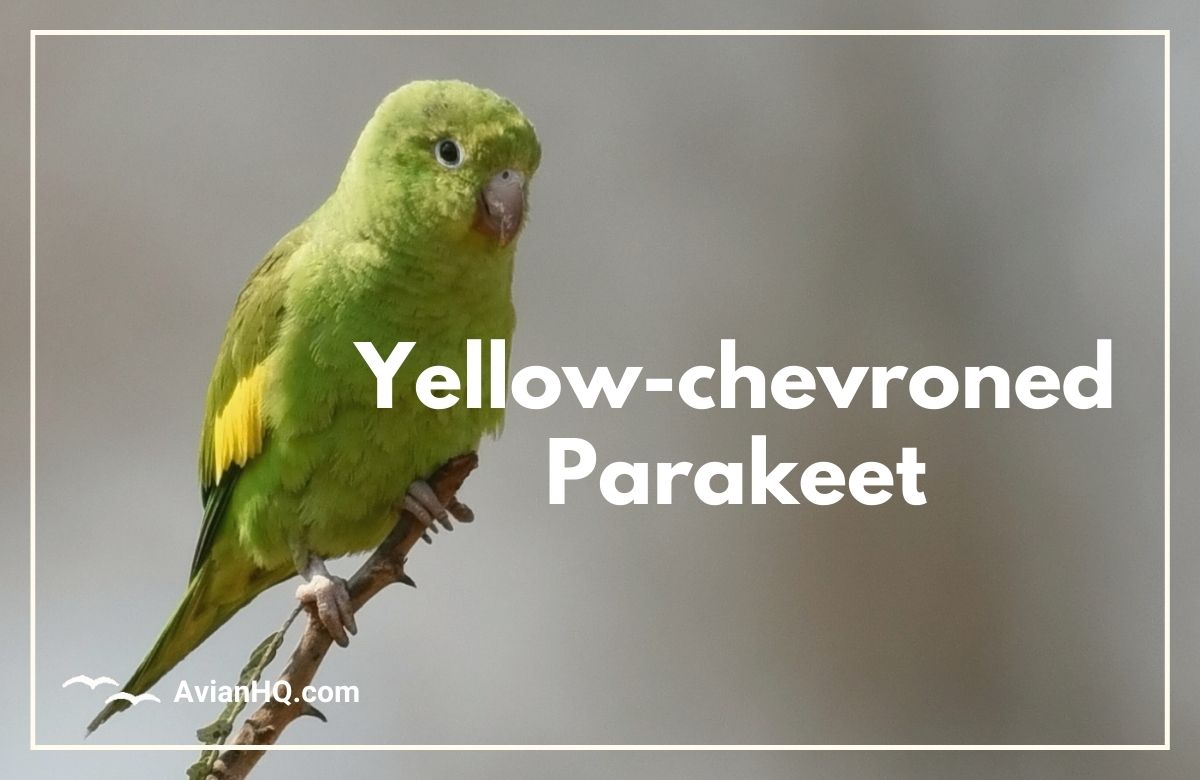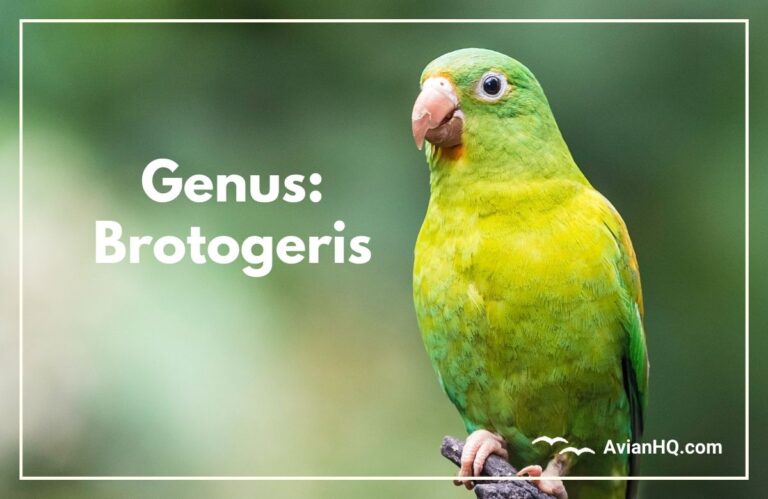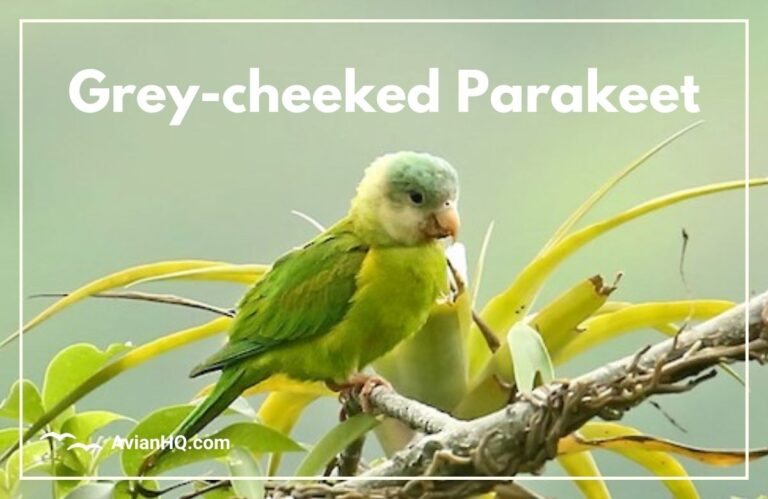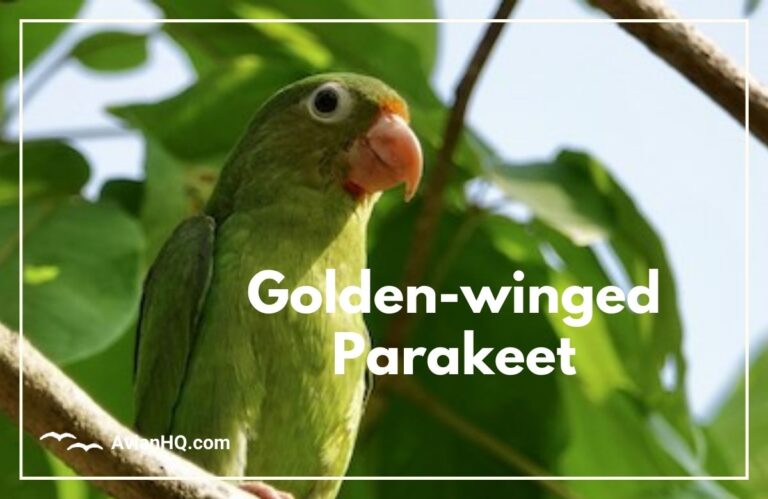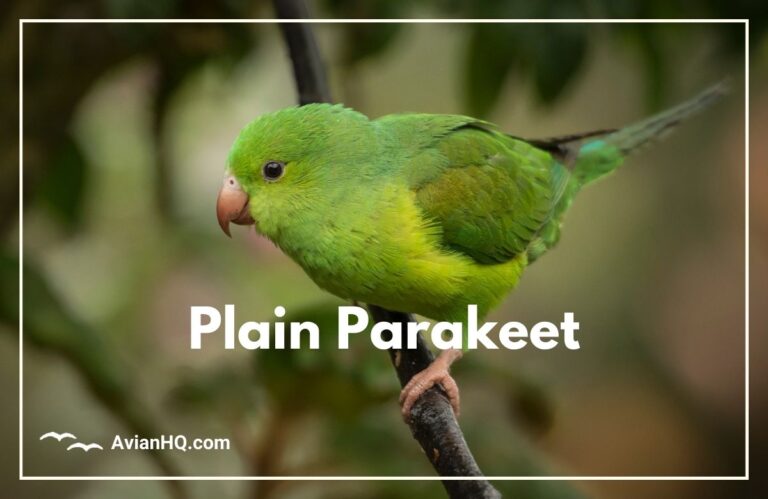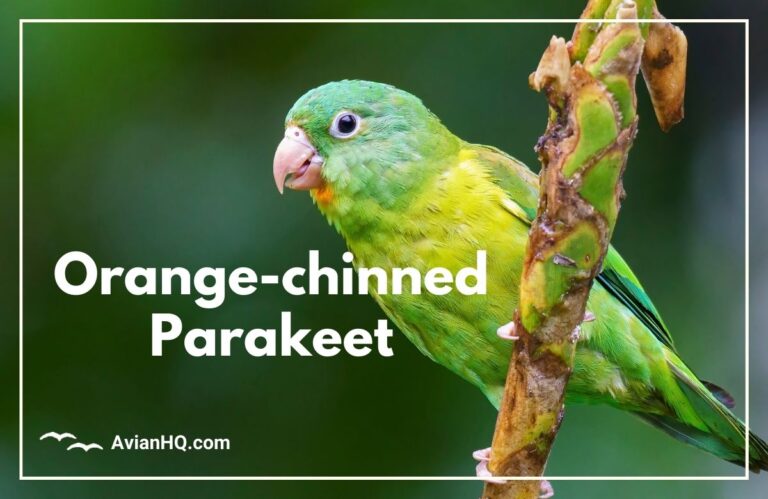Yellow-chevroned Parakeet (Brotogeris chiriri)
As you gaze up into the emerald canopy of a South American rainforest, you catch a glimpse of bright yellow and green wings flashing by. A flock of energetic little parrots chatters excitedly as they flit through the trees. These vibrantly-colored birds are Yellow-chevroned Parakeets (Brotogeris chiriri), a gregarious and fascinating species native to these tropical forests.
“The Yellow-chevroned Parakeet’s bright green plumage and distinct yellow wing markings make it easy to identify as it flies overhead.”
Weighing only 2 to 3 ounces (60 to 80 grams), these diminutive parrots measure around 9 inches (22 centimeters) from the tip of the tail to the top of the head. Their predominately green feathers give them good camouflage when perched among foliage. However, the vibrant yellow chevron patterns on their wings are eye-catching as they fly from tree to tree or gather to roost communally for the night.
Yellow-chevroned Parakeets range across much of northern South America east of the Andes, inhabiting humid lowland rainforests as well as drier savannas and cultivated areas. Here they use their strong beaks to forage on a diverse diet of seeds, fruits, buds, and even occasional insects. Fast-moving flocks chatter constantly as they travel through the forest canopy searching for their next meal.
While not currently threatened, these birds do require vigilant protection efforts to preserve their tropical habitats in the face of ongoing deforestation across South America. Their bright colors, active nature, and loud vocalizations make Yellow-chevroned Parakeets a favorite species for avian enthusiasts and tourists visiting their native regions.
In the sections that follow, we’ll take a more in-depth look at the natural history, physical appearance, habitat ranges, breeding behaviors, and conservation status of this charismatic little parrot.
History and Taxonomy
The Yellow-chevroned Parakeet was first scientifically documented in 1824 by German naturalist Johann Baptist von Spix during his explorations of Brazil. However, indigenous peoples of South America were likely already well acquainted with these small, vibrantly colored parrots that inhabited their forest homes.
Taxonomically, the Yellow-chevroned Parakeet belongs to the large, diverse order Psittaciformes, which contains all species of parrots and cockatoos. More specifically, it is grouped within the family Psittacidae, the true parrots.
Its scientific name, Brotogeris chiriri, comes from Latin roots and refers to the distinctive yellow “chevrons” found on the wings of these birds, resembling inverted V-shapes. The genus name Brotogeris means “seed eater,” an apt description for a small parrot that feeds extensively on nuts, seeds, and grains.
Currently, there are two recognized subspecies of the Yellow-chevroned Parakeet:
- B. c. chiriri – Occurs in Panama, Colombia, Venezuela, Ecuador, Peru, and western Brazil
- B. c. tirica – Native to eastern and northern Brazil as well as southern Colombia and Venezuela
These subspecies have slightly different proportions of yellow to green plumage, but their geographic breeding ranges overlap broadly across most of the Amazon basin region of South America.
Physical Appearance
The Yellow-chevroned Parakeet is a relatively small parrot, though it still displays the classic proportions of its kin with a large head, short neck, stocky body, and long tapered tail. These birds reach an average length of about 9 inches (22 centimeters) from the top of their head to the tip of their tail.
Their total wingspan stretches around 13 inches (33 centimeters). Adults are lightweight, tipping the scales at just 2 to 3 ounces (60 to 80 grams) on average. That’s about the same weight as a baseball!
True to their common name, the most striking feature of these parrots is the vibrant yellow wing markings that resemble chevron shapes. These yellow patches stand out brightly against the predominately green plumage covering most of their body.
Their green feathers show more blueish-turquoise tints around the rump, lower back, and tail. The upper tail often has an orange or reddish wash. The undersides of their wings and tail are more olive-yellow in coloration.
Another splash of color comes from the pale yellow rings encircling their eyes and the grayish-white irises within. Their eyes are surrounded by patches of bare white skin. They sport a short blunt beak typical of small parrots specialized for cracking hard nuts and seeds.
The two subspecies show slight variations in the exact proportions of green and yellow plumage. B. c. tirica tends to have more extensive yellow on the wings, nape, and thighs compared to B. c. chiriri. However, differences are subtle and their breeding ranges overlap broadly.
Habitat and Distribution
The Yellow-chevroned Parakeet is native to tropical regions of South America east of the Andes mountains. Its range extends through parts of Panama, Colombia, Venezuela, Ecuador, Peru, and Brazil.
These small parrots reside primarily in lowland habitats below 3,000 feet (900 meters) in elevation, including humid rainforests, drier deciduous woodlands, savannas, and even cultivated areas like agricultural fields and orchards.
They seem to prefer forest edges, clearings, and semi-open habitats that provide a mix of trees for roosting and feeding while also offering open spaces to gather and forage. The availability of tree cavities for nesting sites also helps dictate their habitat distributions.
Yellow-chevroned Parakeets can be found across much of the Amazon basin region, with their range centered on the countries of Brazil, Peru, Colombia and Venezuela. The northern and southern limits of their breeding distribution are not precisely defined.
Though not yet fully quantified, their widespread habitat range and adaptability to disturbed areas seems to indicate solid overall population numbers. However, ongoing deforestation for logging and agriculture represents an important threat for future monitoring.
No introduced or escaped populations have been documented outside of their native South American homeland. Suitable tropical habitat likely exists for these birds to establish exotic feral populations in other equatorial countries, but quarantines and regulations of the international pet trade may help prevent uncontrolled releases.
Diet and Feeding
The Yellow-chevroned Parakeet is well adapted for an herbivorous diet focused on nuts, seeds, grains, and fruit. Their strong, blunt beak allows them to crack into tough shells and husks to access the energy-rich food inside.
These small parrots are omnivorous, however, and will sample a wide variety of plant-based foods depending on seasonal availability in their local habitat. Documented food items include corn, sorghum, millet, buds, berries, blossoms, and a variety of wild nuts and seeds like palm nuts.
They also occasionally snack on insects and other small invertebrates, which provide an extra dose of protein. But the majority of their calories come from vegetation.
Feeding activity occurs primarily while traveling in fast-moving flocks. The birds chatter loudly as they swarm through treetops searching for their next meal. This helps them find and access as much widely dispersed food as possible.
Flocks may gather into large feeding aggregations of a hundred birds or more whenever an abundant food bonanza is found, such as a fruiting tree or large seed pod. Their strong beaks make quick work of such nutritious treasures.
These feeding behaviors demonstrate the Yellow-chevroned Parakeets’ highly social nature. Staying in a cohesive flock while traveling and foraging provides safety in numbers from predators. It also aids in food discovery by increasing the number of eyes scanning for tasty morsels within the dense rainforest environment.
Breeding and Reproduction
The breeding season for Yellow-chevroned Parakeets varies across their broad South American range, generally coinciding with the onset of annual rainy periods which stimulate blossoming and fruiting cycles. This ensures an abundant food supply for gravid females and growing chicks.
They nest in cavities excavated within the soft inner wood of decaying trees, often choosing sites previously carved out by larger woodpeckers or other birds. Nest sites may be clustered closely together, forming sizable breeding colonies that can include several hundred pairs.
Courtship displays involve mutual feeding between male and female partners to cement the pair bond. Once paired, the female lays a clutch of around 4 white eggs. She incubates them alone for 23 days until they hatch.
The male continues to deliver food as the female broods the nestlings. Both parents share duties feeding the chicks once they grow large enough to stretch their necks out of the cavity opening. Young birds will fledge at 7 to 8 weeks of age.
The average lifespan in the wild is unfortunately not well documented for these small parrots. In captivity, they may enjoy life expectancies up to 15 years or more when properly cared for. Their high-voice chattering and interactive behaviors contribute to their popularity as pets among avian enthusiasts around the world.
Behavior and Ecology
The Yellow-chevroned Parakeet is a highly gregarious species, spending nearly all its time in the company of flock mates. Groups usually contain anywhere from 10 to 30 individuals or more as they travel together through the rainforest canopy searching for food.
Their strong social bonds are maintained through constant contact calls passed between members of the flock. A chorus of noisy chattering provides constant communication about threats and food sources within their home territory.
At night, communal roosts form with hundreds of birds gathering together to sleep. These roosting aggregations offer safety in numbers from nocturnal predators. Several smaller flocks may merge together at traditional roost sites within dense trees or palms.
During the day, the parakeets spend most of their time actively foraging as a unit. The flock works cooperatively to harvest nuts, seeds, fruits and other foods they encounter across an expansive home territory. Their strong bites and nimble beaks allow them to exploit a wide variety of rainforest bounty.
This diet of native vegetation makes Yellow-chevroned Parakeets important seed dispersers for many tree species. Their foraging and roosting behaviors also help pollinate rainforest plant life. Thus they fill an integral ecological role within their specialized tropical habitat.
Despite being preyed upon by falcons, toucans, snakes and other predators, the parakeets benefit from safety in numbers within large, constantly communicative flocks. This allows them to thrive as long as sufficient forest habitat exists to support their lifestyle.
Conservation Status
The Yellow-chevroned Parakeet is currently classified as Least Concern on the IUCN Red List of Threatened Species. This indicates scientists have not detected significant ongoing population declines or risks of extinction under present conditions.
Their extensive geographic distribution across much of northern South America combined with adaptability to disturbed habitats seems to provide resilience. Total world population sizes have not been quantified but are presumed to be relatively robust in the hundreds of thousands to millions of birds.
However, the clearing of native rainforests and woodlands for agricultural and grazing land does pose threats for future habitat reduction. Continued conversions of lowland forests to farms and cattle pastures are shrinking available habitat even for disturbance-adapted species like these parakeets.
Additional pressure comes from illegal capture for the pet trade. As charismatic cage birds, Yellow-chevroned Parakeets are still removed from the wild in several countries to supply demand. Stricter enforcement of trapping bans would help curtail this practice.
While not in imminent peril, increased protections and forest stewardship programs focused on preserving intact tracts of tropical habitats will be needed to ensure thriving long-term populations across their South American strongholds. Responsible ecotourism may also aid conservation goals at protected reserves that shelter Yellow-chevroned Parakeet populations and other wildlife.
Cultural Significance
The bright green and yellow plumage of Yellow-chevroned Parakeets has attracted human attention across their native range for centuries. Indigenous South American tribes likely had native names and lore around these colorful denizens of local forests long before Western contact.
Today they remain popular as ornamental cage birds, especially in Brazil where they are frequently bred and sold as pets. Displaying a perky and interactive nature when properly acclimated, these smart parrots can bond strongly with dedicated owners. Their natural vocalizations are quite loud however, making enclosed indoor housing a necessity.
The Yellow-chevroned Parakeet occasionally appears as a symbolic subject in the folk art and fabrics created by indigenous artisans in areas where it commonly occurs, such as Peru and Colombia. The rainbow hues and regal bearing of parrots in general also make them icons of tropical wildlife appearing in indigenous stories and mythology.
For ecotourists and birdwatchers, sightings of Yellow-chevroned Parakeets rank as avian highlights when exploring lush rainforest preserves across South America. The sight and sound of their vibrant green flocks fast-moving through the jungle canopy make them a signature species representing the biodiversity of this spectacular and imperiled region. Their future is tied to that of the forests they inhabit, making their conservation a matter of hemispheric importance.
Conclusion
The Yellow-chevroned Parakeet remains a thriving tropical species, though not without some conservation concerns going forward. Their bright plumage and energetic, flocking lifestyle make them endemic icons of South American forests for locals and tourists alike to admire.
Efforts to preserve intact rainforest habitats across countries like Brazil, Peru, Colombia and Venezuela will ensure these birds continue to chatter through the jungle for generations. While adaptable to cleared areas when forest health is maintained overall, they do require standing timber for nesting sites and shelter.
Responsible ecotourism focused on showcasing Yellow-chevroned Parakeets and their rainforest homes could provide needed economic incentives to balance wildlife preservation with pressures for development. Their visibility also makes them a useful “umbrella species” for channeling broader habitat conservation goals.
As seed dispersers and pollinators integrated deeply into delicate jungle ecosystems, the welfare of Yellow-chevroned Parakeets reflects the welfare of South American forests as a whole. Ensuring ample protected acreage remains is key so that these diminutive green and yellow wings continue gracing the skies over the Amazon for years to come.

